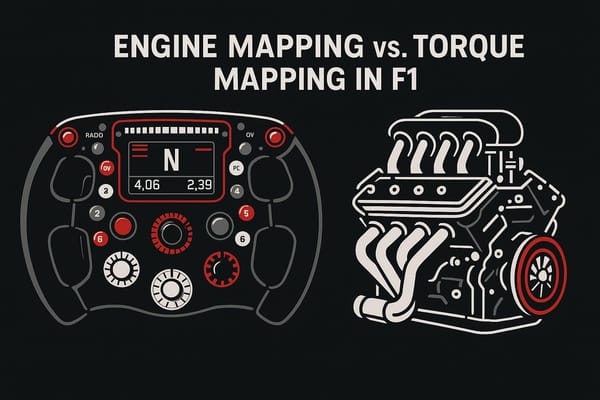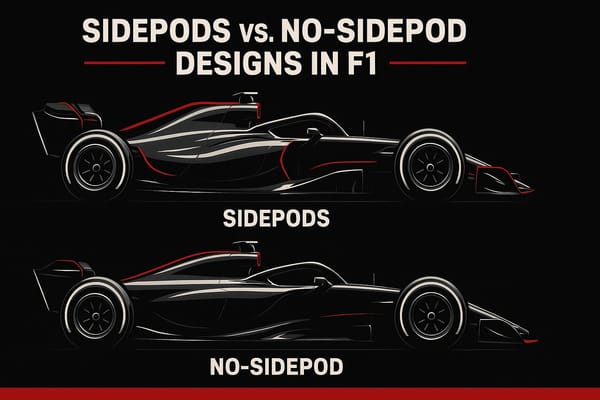F1 Returns to Imola: What’s Changed for the 2025 Emilia Romagna Grand Prix?
Explore the significant changes for the 2025 Emilia Romagna Grand Prix at Imola, from track modifications to new regulations impacting team strategies.

F1 is back at Imola, and 2025 brings big updates to challenge drivers and teams. Here’s what you need to know:
- Track Changes: Tougher track limits with reduced asphalt run-offs, gravel traps at key corners, and new double kerbs push drivers to be more precise.
- Car Updates: Teams focus on improving downforce, handling, and reliability with redesigned floors, rear bodywork, and aerodynamic tweaks.
- New Rules: No more fastest lap bonus points, stricter testing limits, mandatory cooling systems in high heat, and more practice sessions for rookie drivers.
- DRS Adjustments: Stricter deployment rules aim to ensure fairness during races.
These changes make the 2025 Emilia Romagna GP at Imola more demanding and exciting, rewarding precision and strategy while prioritizing safety. Get ready for a race where every mistake could cost teams dearly.
F1 2025 Emilia Romagna GP Preview and Predictions
1. Track Modifications
The 2025 Imola circuit has undergone key changes aimed at making races more dynamic and tightening track limits.
At Turn 9's exit, also known as Piratella, the asphalt run-off area has been reduced. This change demands greater precision from drivers, as going wide now carries a higher risk. Similarly, the gap between Turns 12 and 13 at Acqua Minerali has been narrowed, leaving less room for error and pushing drivers to maintain flawless racing lines through this technical section. These updates are part of an effort to address stricter track limit enforcement, a focus that became prominent after over 1,200 violations were recorded during the Austrian Grand Prix in July 2023 (F1technical.net, May 11, 2025).
At Turns 14 and 15, known as the Gresini corner, the asphalt has been replaced with a gravel trap. This addition introduces immediate penalties for drivers who exceed the limits, making precision at this section even more critical.
The circuit’s signature 30-meter elevation change remains untouched, but new double kerbs have been added at several corners. These kerbs not only assist drivers in staying within bounds but also help officials monitor compliance more effectively.
| Track Section | 2025 Modification | Impact on Racing |
|---|---|---|
| Turn 9 (Piratella) Exit | Reduced asphalt run-off | Forces drivers to approach with more caution |
| Turns 12-13 (Acqua Minerali) | Decreased asphalt buffer | Demands precise lines through a challenging sequence |
| Turns 14-15 (Gresini) | Gravel trap installation | Penalizes deviations instantly |
These updates reshape critical parts of the circuit, blending enhanced safety measures with a greater emphasis on driver skill and accuracy.
2. New Team Equipment
At the 2025 Emilia Romagna GP, teams debuted major technical updates, with Ferrari taking the lead in these changes following a slower-than-expected start to the season.
With Imola's revised layout presenting fresh challenges, teams have focused on redesigning components to tackle the circuit's unique demands. The spotlight is on boosting downforce and refining handling in the technical sections of the track. Some key innovations include:
| Component | Technical Update | Performance Impact |
|---|---|---|
| Floor Design | New composite materials and updated geometry | Greater downforce and improved stability in fast corners |
| Rear Bodywork | Redesigned airflow channels | Reduced drag and better tire management |
| Aerodynamic Elements | Enhanced rear wing designs | Improved grip in technical sections |
Reliability has been just as important as performance in these upgrades. Engineering teams have worked closely with the FIA to ensure all changes meet current regulations. Race engineers now face the task of fine-tuning these updates to balance speed, tire wear, and fuel efficiency, especially in Imola's high-precision zones.
The use of advanced composite materials has played a key role, offering higher strength-to-weight ratios and better structural integrity. This not only helps with lap times but also extends tire life. Meanwhile, extensive simulations have been essential in fine-tuning aerodynamic efficiency, mechanical grip, and power unit settings to handle Imola's elevation changes effectively.
These updates will be a decisive factor in how teams perform on Imola's demanding circuit, particularly given the track's tougher conditions after its recent changes.
3. Rule Changes
The 2025 Formula 1 season comes with a set of new rules that could significantly alter team strategies and race dynamics.
One major update is the removal of the extra point for the fastest lap, a rule that’s been in place since 2019. This change is expected to impact how teams approach late-race pit stops, as the incentive to chase that additional point is now gone.
Driver safety is also taking center stage with new heat management protocols. These were introduced after the extreme conditions at Qatar in 2023, where high temperatures and limited tire-stint lengths pushed drivers to their limits. As F1 Analyst Bernie Collins notes:
"Implemented in response to Qatar 2023 when extremely hot conditions and restricted tyre-stint lengths led to a flat-out pushing race for drivers."
If track temperatures rise above 31°C (about 87.8°F), officials can now declare a Heat Hazard. This requires teams to use driver cooling systems, and cars will carry an additional 5kg (11 pounds), raising the minimum car weight to 800kg (1,763.7 pounds).
Aerodynamic Regulations
The technical rules for aerodynamic components have also been tightened, with stricter limits on flexibility. Here's a breakdown of the changes:
| Component | New Limit | Implementation |
|---|---|---|
| Rear Wing Mainplane | Maximum 6mm flex | Immediate |
| Upper Flap | Maximum 7mm flex | Immediate |
| Front Wing (Vertical) | Reduced to 10mm flex | From Spanish GP onwards |
| Front Wing Trailing Edge | Maximum 3mm flex | From Spanish GP onwards |
These adjustments aim to reduce aerodynamic advantages gained through excessive flexing, forcing teams to adapt their designs.
Testing and Driver Development
Teams will now face stricter limits on Testing of Previous Cars (TPC). Each team is allowed up to 20 days of TPC per season, with race drivers restricted to a maximum of four days and 1,000km (621.4 miles) of running.
On the development side, rookie drivers are getting more opportunities. Teams are now required to field a rookie in Free Practice 1 twice per car, totaling four sessions per season.
DRS Adjustments
Changes to DRS (Drag Reduction System) regulations are also in play. Article 3.10.10 of the 2025 technical guidelines specifies:
"Except in the event of a DRS failure or the transitioning from one position into the other, the DRS bodywork can have only 2 positions, such that the DRS bodywork position must be the same before and after each state of deployment. The transition time between the 2 positions must be less than 400ms."
This tighter control over DRS usage ensures uniformity and limits potential loopholes in its deployment.
Benefits and Drawbacks
Building on the technical and regulatory updates discussed earlier, let's dive into how these changes impact various aspects of racing dynamics, including track modifications, technical regulations, and strategic approaches.
Track Modifications Impact
Changes to track design are reshaping how teams and drivers approach races. These updates penalize mistakes while rewarding precision, introducing both opportunities and risks.
| Modification | Benefits | Drawbacks |
|---|---|---|
| Reduced Asphalt Run-off | • Encourages teams to fine-tune racing lines and strategies • Promotes more precise driving |
• Fewer recovery options for drivers • Higher risk of race-ending incidents • Slower lap times in some cases |
| New Double Kerbs | • Improves track limit enforcement • Ensures consistent application of penalties |
• Increases risk of car damage • Forces cautious driving, reducing overtaking opportunities |
| Gravel Trap Installation | • Adds stricter penalties, potentially increasing race drama | • Greater chance of race-ending incidents • Limits recovery options for drivers |
These updates are designed to challenge drivers and teams, pushing them to adapt and refine their tactics for success.
Technical Regulation Effects
The latest technical regulations aim to improve safety and create a more level playing field. However, they also introduce new challenges, particularly in areas like weight management and cooling system efficiency. Teams are now tasked with balancing performance with these regulatory demands, which can affect how cars perform on race day.
Strategic Implications
Changes to regulations and strategy rules are reshaping how teams approach the season. For instance, removing the fastest lap bonus shifts the focus entirely to race positions, while reduced testing days demand more efficient use of resources and time.
| Aspect | Benefits | Drawbacks |
|---|---|---|
| Cost Management | Helps reduce the financial burden of testing | Limits opportunities for technical development |
| Young Driver Program | Opens doors for emerging talent | May disrupt established driver hierarchies |
| Car Development | Levels the playing field across teams | Could slow technological advancements over time |
These adjustments encourage teams to prioritize precision and long-term planning. While they may limit overtaking and recovery options, they reward careful strategy and flawless execution - qualities that add to the intensity and competitiveness of modern racing.
Final Analysis
The updates to Imola for 2025 represent a major evolution in circuit design, raising the stakes for both racing intensity and the overall fan experience. These changes build upon earlier track modifications, creating a platform that will influence how technical upgrades and strategic decisions play out during the race.
The reconfigured track strikes a challenging balance between risk and reward. The addition of double kerbs with built-in physical limits has effectively addressed past controversies over track limits, turning critical sections into high-stakes areas where precision is non-negotiable. With the circuit now more physically demanding, teams must rethink their technical setups to meet these new challenges.
For Ferrari, the stakes are particularly high. As highlighted earlier, their Imola-specific updates reflect the importance of their home race. After securing just one podium finish in the early 2025 season, these modifications could play a decisive role in their championship ambitions.
| Aspect | 2024 Configuration | 2025 Changes | Impact |
|---|---|---|---|
| Run-off Areas | Extensive asphalt zones | Reduced at key corners | Greater consequences for driver errors |
| Track Limits | Regulatory enforcement | Physical limits added | Natural penalties for exceeding limits |
| Racing Style | Aggressive approaches | Precision-focused | Increased technical demands |
"The reduction of asphalt run-off areas at corners like Piratella and Acqua Minerali reintroduces natural consequences for driver errors, potentially increasing the likelihood of race-ending incidents", according to the FIA safety assessment.
Imola's transformation mirrors a broader trend in Formula 1, moving away from overly sanitized layouts and embracing designs that highlight driver skill. The complete overhaul of the pit facilities and paddock areas, overseen by Hermann Tilke, further reinforces the circuit’s commitment to combining its rich history with modern F1 standards.
These updates have created a more technically demanding track that prioritizes driver expertise while adhering to the FIA's stringent safety requirements and "1" homologation rating. The result is a race environment where success will hinge on razor-sharp precision and strategic brilliance, shaping both team tactics and driver performance.
FAQs
What impact will the 2025 Imola track changes have on drivers and the race?
The 2025 Emilia Romagna Grand Prix at Imola promises to shake things up with newly introduced track modifications. These updates aim to create better overtaking opportunities while prioritizing safety, but they’ll also push drivers to rethink their strategies and fine-tune their car setups. With tighter corners and adjusted braking zones, precision and quick adaptability will be key.
For the teams, these changes could alter the competitive landscape, depending on how well their cars respond to the revamped circuit. Factors like aerodynamic performance and tire management are expected to play an even more crucial role in shaping the race’s outcome. Fans can look forward to a more unpredictable and action-packed event, where strategy and split-second decisions could make all the difference.
How have teams modified their cars to tackle the updated 2025 Imola circuit?
Teams have rolled out several updates to their cars in preparation for the 2025 Emilia Romagna Grand Prix, tailored specifically to the revamped Imola circuit. Among the most notable changes are aerodynamic refinements designed to tackle the newly reconfigured high-speed corners, along with suspension modifications to ensure better stability on the resurfaced areas of the track. On top of that, teams are fine-tuning engine performance to strike the perfect balance between top speed on straights and maintaining fuel efficiency.
Another area to watch is tire strategies. With the updated track layout, teams may adopt a bolder approach to tire management, focusing on maximizing grip and durability to handle the circuit's fresh challenges. All these upgrades are aimed at boosting driver performance and ensuring the cars are ready to conquer the demands of the redesigned course.
How will the removal of the fastest lap bonus point impact team strategies in the 2025 F1 season?
The decision to eliminate the fastest lap bonus point starting in 2025 is likely to shake up race-day strategies. Without the extra incentive, teams may think twice about making late pit stops just to chase the fastest lap. Instead, the focus could shift toward maintaining strong overall race positions and sticking to long-term plans rather than risking last-minute moves.
This adjustment might also encourage teams to emphasize tire management and steady race pace over attempting a single blistering lap. The result? A potentially more even playing field across the grid. Fans could see a noticeable change in how teams handle critical decisions during the race, adding a fresh layer of intrigue to the competition.




